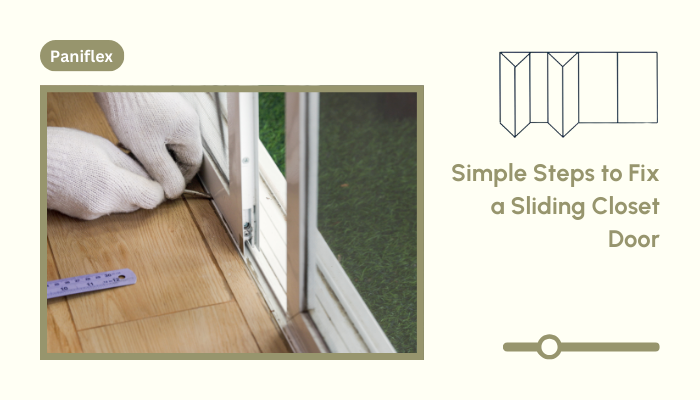Are you an interior designer or architect facing challenges with sliding closet doors in your projects? Whether working on a high-end residential renovation or a commercial space, knowing how to fix sliding closet door issues can save time, money, and client satisfaction. Let’s dive into some professional-grade solutions that will keep your designs functioning as beautifully as they look.
Repairing Loose and Unstable Doors
Nothing undermines a sleek design like a wobbly closet door. Here’s how to address this common issue:
- Check and secure the rail system: Inspect the upper track for any signs of looseness or damage. Tighten any loose screws and adequately align the rail.
- Replace or tighten floor guides: These small but crucial components keep the door in place at the bottom. If they’re worn or loose, replace them or pull them as needed.
- Ensure screws holding guides are secure: Double-check that all screws are tight, and use a power drill for efficiency.
- Inspect tracks and wheel braces for damage. Look for any bends or dents that could impede smooth movement. Minor issues can often be fixed, but components experiencing significant damage may need to be replaced.
Ready to experience the benefits of custom closet doors? Explore our range of Paniflex products now.
Pro Tip: For high-end projects, consider Paniflex’s premium track systems. Paniflex designs its premium track systems to ensure smooth operation and long-term durability.
Ready to tackle doors that won’t stay on their tracks? Let’s jump right into it.
Fixing Doors That Fall Off Tracks
A door off its track is not just unsightly—it’s unusable. Here’s how to fix sliding closet door derailments:
- Check door alignment and adjust mounting screws: Often, a simple realignment can solve the problem. Loosen the mounting screws, adjust the door’s position, and retighten.
- Manually adjust brace and wheel assembly: If alignment doesn’t solve the issue, you may need to change the wheel assembly. Turning a screw typically raises or lowers the wheels.
- Replace broken or bent wheel mechanisms: Damaged wheels can cause recurring issues. For a long-term fix, replace them with high-quality alternatives.
- Clean and inspect the door track for debris and minor damage: Sometimes, the culprit is as simple as built-up dirt or a small obstruction in the track.
Now that we’ve covered derailments let’s focus on those stubborn, jammed doors.
Addressing Jammed Doors
When addressing jammed doors, keep these tips in mind to ensure smooth sliding every time:
- Inspect and tighten door rollers and braces: Loose components are often the culprits behind sticky doors. Use a screwdriver to tighten any visible screws on the rollers and braces. Pay special attention to the roller brackets, as these can loosen over time due to the door’s weight and movement.
- Replace damaged parts: Don’t hesitate to replace any worn or damaged components. Look for signs of corrosion, cracks, or excessive wear on the rollers. Even minor imperfections can cause significant issues in indoor movement.
- Clean door track: A thorough cleaning can often resolve jamming issues caused by debris. Use a vacuum with a narrow attachment to remove loose dirt, then follow up with a damp cloth to pick up any remaining particles. A mixture of equal parts water and white vinegar for stubborn grime can work wonders.
- Handle heavy doors with care: For larger closet systems, consider Paniflex’s specialized solutions, designed to handle heavier doors with ease. These robust systems incorporate heavy-duty rollers and tracks to support substantial weight without compromising smooth operation.
- Ensure clean and smooth rollers for movement: Regular maintenance of rollers can prevent many jamming issues before they start. Apply a small amount of silicone-based lubricant to the rollers every few months to keep them moving smoothly.
And just like that, you’ve conquered the common issues that make closet doors a headache. With these professional-grade solutions, you’ll ensure your clients’ closet doors glide as smoothly as the rest of your designs flow.
Speaking of smooth gliding, let’s figure out what to do when the wheels won’t stay in their tracks.
Putting Wheels Back in the Track
When wheels jump the track, follow these steps:
- Lift the door gently to put the roller wheels back on the track. For larger doors, this often requires two people. Carefully lift the door and align the wheels with the track, then gently lower it back into place.
- Ensure smooth movement after wheels are back in place: Test the door’s operation to confirm you successfully fixed it. Slide the door back and forth several times to ensure it moves smoothly without catching or jumping.
- For double-track doors, release the spring to reposition the wheels. This may require a specialized tool, often provided by manufacturers like Paniflex. The spring mechanism helps keep the wheels in place, so temporarily releasing it allows for easier repositioning.
Whew! Let’s shift gears and talk about keeping those tracks dirt and rust-free for optimal performance.
Cleaning Dirt and Rust from Tracks
Maintaining clean tracks is crucial for optimal door function, so let’s dive into the nitty-gritty of keeping those tracks spotless:
- Remove doors and create a cleaning solution: Start by carefully removing the doors from their tracks. Mix dish soap, water, and vinegar, which works well for most situations. For stricter buildup, consider a specialized track cleaner from suppliers like Paniflex.
- Spray tracks and wait before scrubbing with a brush. Apply your cleaning solution generously to the tracks. Let it sit for 10-15 minutes to help loosen dirt and grime. The waiting period allows the cleaning solution to break down stubborn debris.
- Remove stubborn debris with repeated cleaning: Don’t feel free to repeat the process for particularly troublesome areas. Use a soft-bristled brush to scrub the tracks, paying extra attention to corners and crevices where dirt accumulates.
- Clean wheels and ensure tracks are dry: While the doors are off, take the opportunity to clean the wheels thoroughly. Use the same cleaning solution and a soft cloth to wipe down each wheel. After you clean both tracks and wheels, dry them with a clean, lint-free cloth to prevent moisture-related issues.
- Apply lubricant and rehang doors to distribute oil: Often, a silicone-based lubricant works best for closet door tracks. Apply a thin layer along the entire length of the track. After applying the lubricant, rehang the doors and slide them back and forth several times to distribute it evenly.
One last thing before we wrap up—let’s make sure those annoying loose screws are tightened up.
Tightening Loose Screws
This simple fix can resolve many issues:
- Tighten screws inside tracks and on wheel assemblies: Ensure a snug fit by using the appropriate screwdriver. Check all visible screws, including those on the track, rollers, and door frame.
- Consider cleaning tracks before rehanging doors: Take the opportunity to perform a thorough cleaning. This ensures optimal performance after tightening all screws.
Ready to experience the benefits of custom closet doors? Explore our range of Paniflex products now.
When a simple cleaning isn’t enough, it’s time to consider more serious repairs, like broken wheels or door damage.
Repairing or Replacing Broken Wheels and Damaged Doors
When simple fixes aren’t enough:
- Inspect and replace broken wheels. Quality matters here—opt for durable, smooth-rolling wheels made of materials suitable for the door’s weight and usage frequency.
- Examine and repair minor door damage: You can often fix small dents or scratches without replacing the entire door. Wood filler and a fresh coat of paint can work wonders for wooden doors. For metal doors, consider using a metal filler or patching compound.
- Correct track bends and tightens screws: Minor bends can sometimes be straightened without replacement. Use a rubber mallet to tap the track back into shape gently, careful not to cause further damage.
- Align floor guides properly: Proper alignment ensures smooth operation and prevents future issues. Adjust the floor guides to match the door’s position and movement, ensuring they provide adequate support without causing friction.
Conclusion
Knowing how to fix sliding closet door problems is an invaluable skill for design professionals. From realigning wheels and cleaning tracks to tightening screws, these simple steps can resolve most issues efficiently. However, consulting specialists for more complex problems or when dealing with high-end custom closet systems is wise.
Need expert assistance or looking to upgrade your closet door systems? Paniflex offers a range of customizable, high-quality sliding door solutions that are perfect for your next design project. Their team can provide professional guidance on installation, maintenance, and repairs to ensure your closet designs look stunning and function flawlessly for years to come.
Ready to elevate your closet designs? Explore Paniflex’s custom sliding door options and installation guides to bring style and functionality to your next project.






